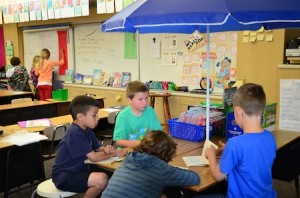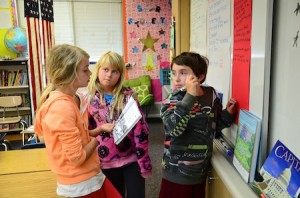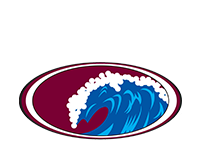 At the end of the school year, most kids trade their book bags and hyper-scheduled days for fun in the sun or just sleeping in. But about 270 kids in grades K-8, and 126 high school kids have traded mornings at the beach for four hours of class time for part of summer. And, whether they see it that way or not, it’s a privilege.
At the end of the school year, most kids trade their book bags and hyper-scheduled days for fun in the sun or just sleeping in. But about 270 kids in grades K-8, and 126 high school kids have traded mornings at the beach for four hours of class time for part of summer. And, whether they see it that way or not, it’s a privilege.
“We’re very lucky that our district still offers summer school,” said Stacy Quirarte, the Thurston math teacher and department chair who becomes the principal of summer school for grades K-8 in June and July. She said that many schools no longer offer summer school because of budget constraints.
Summer school takes on a different meaning, depending on the grade level. The program for grades K-8 has been designed as an intervention program for students with learning difficulties in certain areas. “It is a seamless continuation of our regular school year intervention program,” explained Nancy Hubbell, outgoing assistant superintendent of instructional services. At the very least it helps prevent these students from losing ground during the summer hiatus. At best, some may gain ground.
The summer program at Laguna Beach High School is primarily credit recovery, explained Hubbell. It gives students the chance to re-take a class in which they received a D or an F. The entirely voluntary high school program also includes a class for special ed students and a Model United Nations (MUN) summer program, which is required for any incoming ninth graders who wish to participate in the MUN as freshmen.
Children participate in the main K-8 summer program by invitation only. While attendance is encouraged, it’s not mandatory. To decide which kids should be invited to summer school, Quirarte begins working with the elementary school teachers in April, looking at various benchmark figures and test scores, as well as getting their feedback on the students.
Two classes are voluntary: accelerated math and Mandarin Chinese. Any incoming sixth-grade student who wishes to get a jump on math can take the accelerated math class, in which the teacher covers the entire sixth-grade curriculum in 18 days, four hours a day. Students who complete the course and pass a placement test can skip sixth-grade math in the fall, beginning instead with seventh-grade pre-algebra.
Sixth graders receive instruction in Mandarin Chinese as part of a language wheel introducing them to several languages during the year. Those who wish to pursue Mandarin beyond that level, have the option of taking an after school course, as well as the summer school course.
A recent visit to both campuses reflected the divergent atmospheres of the two programs.
A somber atmosphere reigns at the high school where students almost evoke a mood of penance as they sit quietly, intent on the teacher, in order to recuperate credit or improve scores in a slew of English, math and social science classes. Participants in the online credit recovery program, which is available to students during the regular school year and continues into the summer, direct their gazes to computer monitors instead of a teacher, but the mood remains the same.
In almost a complete about face, the classrooms for the K-8 program, held at Top of the World Elementary School, exuded a summer camp ambiance. Mary Blanton’s class of incoming fourth graders, for example, though engaged in learning activities, seemed alert and primed for excitement, a feeling aided by strategically placed beach umbrellas to help ease their pain of having swapped beach time for class time.
“You have to try to keep them engaged,” said Blanton, normally a third grade teacher at El Morro and the district’s teacher of the year. Blanton does her best to make the experience fun, using themes and games to help kids absorb reading and math skills. This week, she lured kids to read what she termed “high interest non-fiction” books on the Revolutionary War and included a number of drawing and other activities to complement their reading. To supplement math lessons, Blanton engages her students by tossing them a football divided into grids labeled with numbers. When a student catches the ball, he or she must perform a math equation using the numbers that their fingers landed on when they caught the ball. A “math wars” competition, with a posted scoreboard showing which kids make the position of “fleet admiral” through various successes, adds more excitement.
Science lessons to learn about the colors of light involved blowing bubbles, and future themes will include the Olympics and the Orange County fair. It’s all about “giving kids a reason to read and learn and bring in some fun,” said Blanton, who credits Quirarte for allowing teachers the latitude to pursue less traditional avenues of learning and to bring in guest speakers. Laguna Beach Wilderness Park ranger Winter Bonin is scheduled to bring in live critters when she talks to the kids.
The K-8 program, which operates four hours a day from June 25 through July 20, provides one classroom per grade level for grades 1-6, with “pull outs” offered in language and math, in which students with troubled areas are taken aside for more intense instruction in small groups. English language learners receive similar pull-outs. The program for incoming seventh and eighth graders offers two classes each, two-hours long, for math and language arts. And there is a pre-K class for special ed kids, in addition to the Mandarin and accelerated math classes.
“Summer school is a lively place!” said Hubbell.




